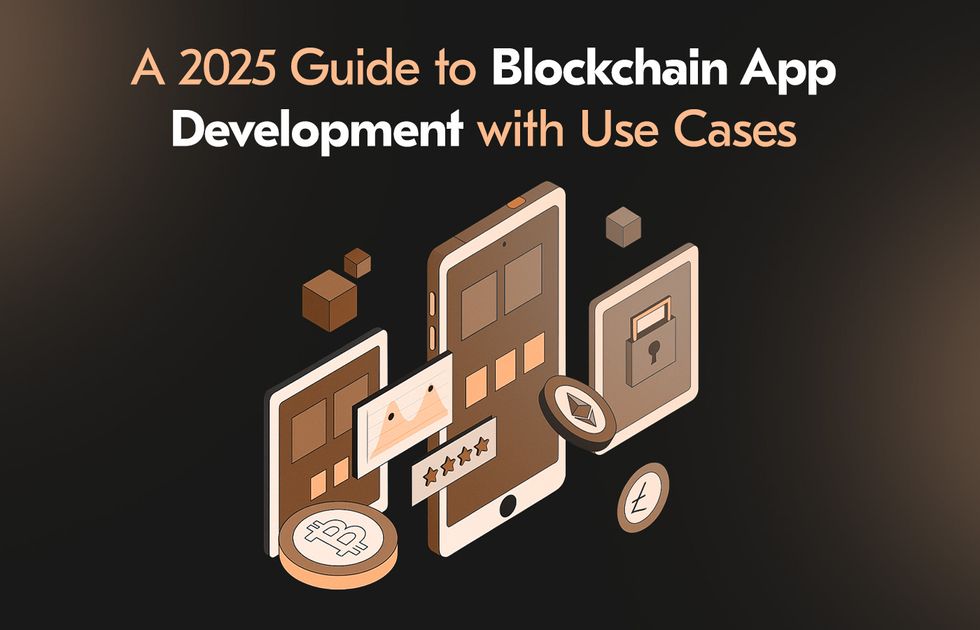
Key Takeaways
- Industries like finance, logistics, and real estate are already seeing real-world ROI from blockchain adoption.
- With over 126 blockchain unicorns in 2025 and the market projected to grow to $1.87 trillion by 2034, the need for blockchain app development has never been greater.
- Blockchain ensures real-time traceability, particularly useful for tracking goods, verifying provenance, and sharing medical data securely.
- Acropolium has delivered 87 blockchain solutions, with proven results such as 44% increases in trading volume for a crypto exchange.
The term “blockchain” has become increasingly popular, especially among developers and businesses aiming to keep up with tech trends. With 126 blockchain-based unicorns entering the market in 2025, the latter, in turn, invests in blockchain app development.
What began as the backbone of cryptocurrencies like Bitcoin has transformed into a versatile technology with a wide range of applications. Today, its potential goes far beyond digital payments. Blockchain is now being explored as a way to improve industries like supply chain management, healthcare, and finance.
Decentralized applications offer clear advantages over traditional systems — greater transparency, improved security, faster transactions, and, in many cases, enhanced privacy for users.
Standing among the 20 leading blockchain developers, Acropolium is here to guide you through the peculiar challenges of making blockchain-based solutions. Let’s explore the benefits, use cases, and tips that will help you to develop blockchain apps.
What Is Blockchain Applications Development?
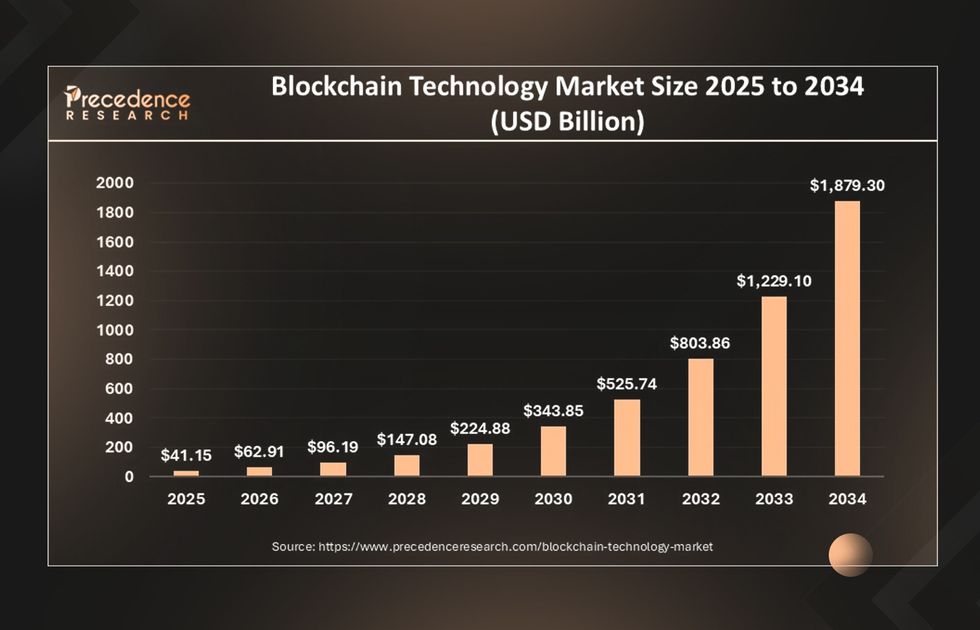
Blockchain app development is the process of building applications that run on decentralized blockchain networks instead of centralized servers. These apps, often called dApps (decentralized apps), are used in a wide range of industries, from finance and supply chain to government and healthcare.
By using peer-to-peer networks, blockchain apps remove the need for intermediaries, offering users more control, transparency, and security. Popular use cases include cryptocurrency wallets, DeFi platforms, and systems for managing digital assets or supply chains.
Blockchain’s real power lies in how it records and secures data. Once information is added to the blockchain, it can’t be changed, making it ideal for storing things like transaction histories, medical records, and ownership rights.
And the market is booming: the blockchain technology is expected to grow from $41.15 billion in 2025 to over $1.87 trillion by 2034, expanding at an impressive 52.9% annual growth rate.
Reasons to Build a Blockchain App
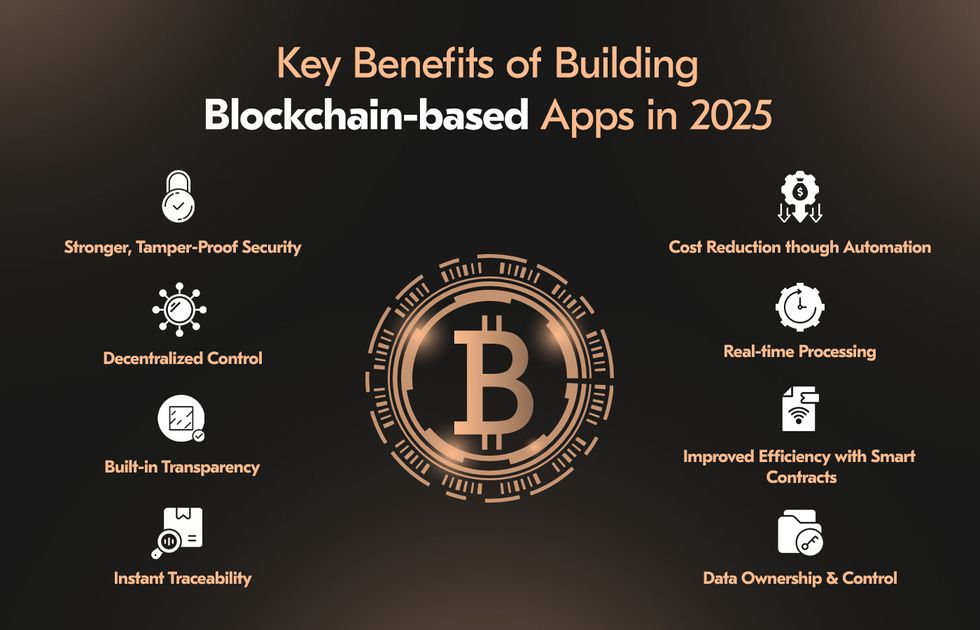
Despite global economic uncertainty, the blockchain sector continues to demonstrate strength and adaptability, fostering an environment where innovation can thrive. Whether you’re building blockchain applications in finance, healthcare, supply chain, or identity management, it offers a modern way to solve real-world problems with smarter infrastructure.
Long story short, blockchain-based systems are designed to be more resilient, efficient, and trustworthy from the ground up. Here’s why many businesses and developers are making the switch.
Enhanced Security: Tamper Proof by Design
Blockchain app developers use advanced cryptography to secure data, making it extremely difficult to hack or alter any part of the system. Each block comes with a unique hash and is connected to the previous one. That means changing any block would require altering the entire chain across all nodes in the network, which is practically impossible.
This level of security is crucial for apps handling sensitive data, such as healthcare records, identity verification, or digital contracts. Additionally, smart contracts (self-executing agreements written in code) further enhance security by automating transactions and eliminating the need for third-party validation.
Decentralization: No Single Point of Control or Failure
Unlike traditional applications that rely on centralized servers, blockchain apps development involves decentralized networks where no single party has full control. Instead, every participant owns a ledger’s copy and contributes to validating transactions.
This architecture increases resilience and reliability, since the app continues to function even if one or more nodes go offline. It also prevents censorship or manipulation, as there’s no central authority that can override or tamper with the system. This is especially valuable in finance, content sharing, and governance platforms.
Greater Transparency: Built-In Audit Trails
Every transaction on a blockchain is recorded in a shared, immutable ledger that can be accessed by all network participants. By building blockchain applications, you invest in a transparent system where all actions are visible, traceable, and verifiable in real-time.
In industries like supply chain, banking, and logistics, this transparency improves accountability, reduces fraud, and ensures compliance. Businesses can track the complete lifecycle of a product or asset without relying on intermediaries or manual checks — from origin to end user.
Instant Traceability: Real-time Processing
Regular financial systems can take hours or even days to process and settle transactions, notably across borders. Blockchain operates 24/7, with near-instant transaction validation depending on the network.
By removing delays caused by intermediaries and manual verification, blockchain apps provide quicker execution, which is essential for industries like e-commerce, digital payments, and real-time data sharing.
Cost Reduction: Automation & Smart Contracts
Blockchain app development removes the need for intermediaries, such as banks, brokers, or clearinghouses. With peer-to-peer transactions and smart contracts, processes that once required multiple steps and fees can now be completed faster and cheaper.
This is also impactful in cross-border payments, lending, and other financial services where traditional systems are slow and expensive. Businesses can also reduce administrative overhead, transaction fees, and infrastructure costs by integrating blockchain solutions.
Improved Efficiency and Speed: Auto-Intelligence over Manual Inputs
Since smart contracts get rid of the need for intermediaries or manual verification, they enable the prompt execution of transactions or workflows. For example, in supply chain logistics, a smart contract can automatically release payments once goods are confirmed as delivered via IoT sensors.
This way, managers reduce human error and shorten turnaround times while maintaining consistent performance across complex operations.
User Empowerment: Data Ownership and Control
In conventional apps, third-party vendors often store and monetize user data. Blockchain app development shifts control back to the user, allowing them to own their digital identity, assets, and information.
Thus, users of a blockchain-based identity app can choose what data to share and with whom, without handing over full access. Such autonomy aligns with modern expectations around data privacy, giving users more trust in the platforms they use.
Blockchain Application Development: Use Cases by Industry
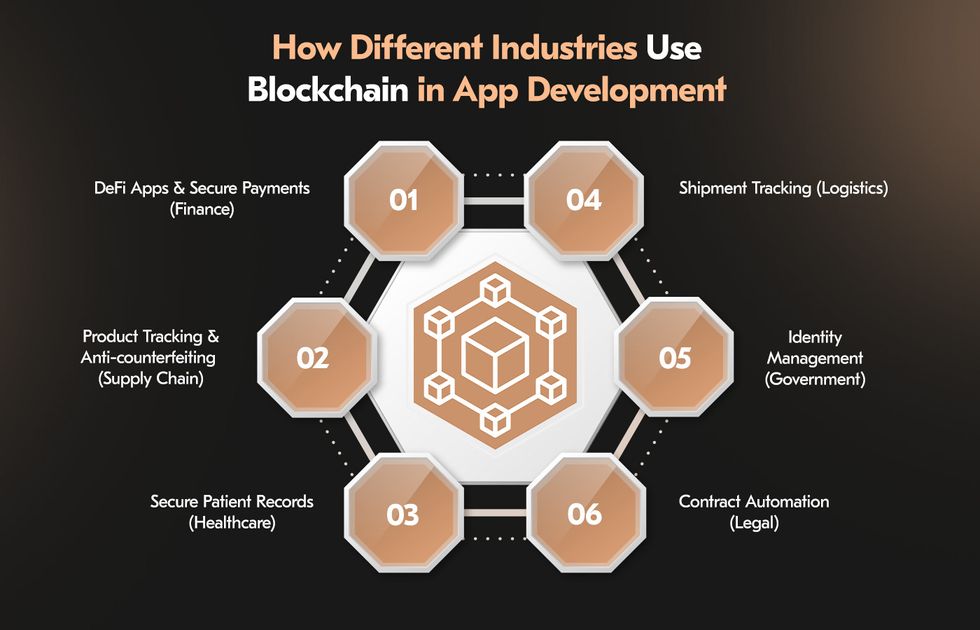
Blockchain application development services are powering tangible, real-world solutions across industries. From finance to government services, leading companies are deploying blockchain to deal with inefficiencies, secure sensitive data, and automate outdated processes.
Finance & Banking: DeFi Apps & Secure Payment Platforms
The financial sector remains a trailblazer in blockchain adoption, which is considered the top fintech trend. Revolut, a global fintech giant, has integrated blockchain into its digital banking services, offering secure crypto custody and live asset transfers.
Société Générale, one of Europe’s major banks, has issued tokenized bonds on the Ethereum blockchain, streamlining settlement processes. Meanwhile, MakerDAO continues to power decentralized lending and borrowing through its widely used DeFi platform.
Supply Chain: Product Tracking, Anti-counterfeiting
Blockchain is boosting transparency and traceability in supply chains. Walmart, for instance, uses IBM Food Trust, a blockchain solution now used by multiple global food suppliers to track product movement and reduce spoilage.
De Beers, the diamond business, invested in blockchain app development services to build Tracr, a proprietary platform that verifies the ethical sourcing and authenticity of diamonds.
Healthcare: Secure Patient Records & Data Sharing
Securing and managing patient data remains a key blockchain use case. Guardtime, an Estonian company, built a blockchain-based system for the country’s national health service, ensuring the integrity of patient medical records.
Also, Change Healthcare (now part of UnitedHealth Group) has implemented blockchain to streamline claims processing, reducing errors and administrative expenses.
Logistics: Shipment Verification & Provenance Tracking
Global logistics firms are using blockchain to breathe transparency and reliability into their workflows. DHL, for instance, piloted a blockchain-based serialization system to track pharmaceuticals across the supply chain, helping to combat counterfeit drugs.
FedEx has also partnered with a blockchain application development company to deploy blockchain and resolve customer disputes with transparent shipment records.
Real Estate: Tokenized Assets & Smart Contracts
While over 50% of retail investors are eager to invest in tokenized assets, the real estate industry doesn’t stand still, too.
Blockchain is modernizing how real estate assets are bought, sold, and tokenized. Propy, a U.S.-based platform, has successfully executed fully digital and blockchain-recorded real estate transactions in states like Florida and California.
Mattereum, a UK startup, also allows tokenized ownership of real-world assets, offering legally enforceable smart contracts for property and high-value collectibles.
Government & Legal: Identity Management & Contract Automation
Several governments are testing blockchain to improve digital infrastructure. Zug, Switzerland — a leading hub for blockchain innovation — uses blockchain-based digital IDs for local e-voting and public services.
In the legal field, OpenLaw has built smart legal contracts integrated with Ethereum to automate contract execution.
Types of Blockchain
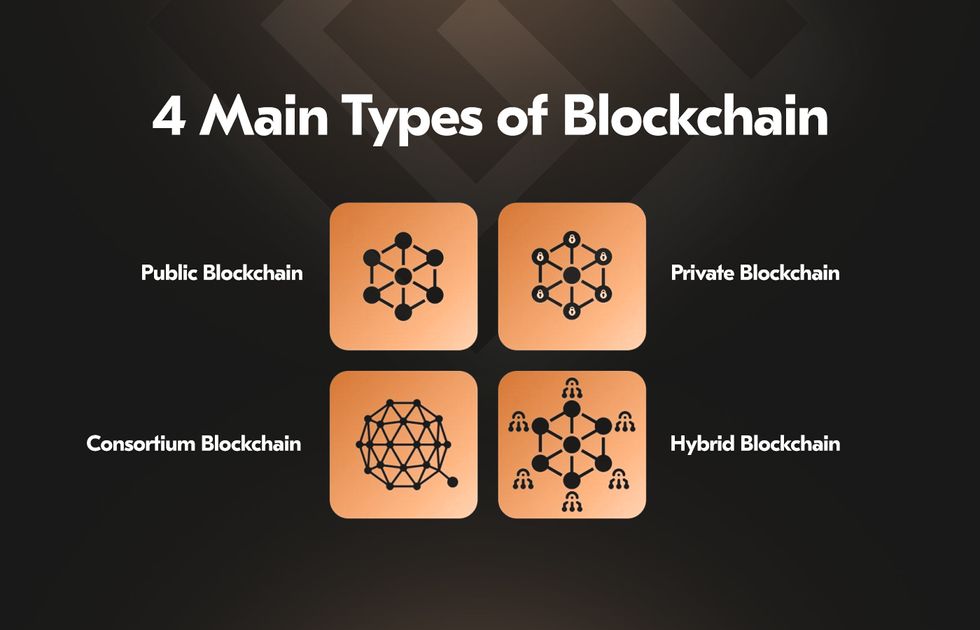
Depending on business needs, regulatory requirements, or user access levels, organizations can choose from several types of blockchain architectures. Each type offers its own balance of transparency, decentralization, and control.
Below are the four main types of distributed ledgers and their use cases that you should be familiar with before you develop blockchain applications.
Permissionless Blockchain (Public)
A permissionless or public blockchain allows anyone to join, read, write, or participate in the network. These blockchains are fully decentralized, ensuring transparency and immutability. Since all records are public, it’s nearly impossible to alter historical data without consensus from the entire network.
Popular Use Cases:
- Bitcoin and Ethereum operate on permissionless blockchains
- NFT marketplaces and decentralized finance (DeFi) platforms also typically rely on public chains to enable open access to trading, lending, and borrowing services
Permissioned Blockchain (Private)
Permissioned (or private) blockchains are governed by a single organization or a group of trusted entities. Only approved participants and blockchain app developers can access and interact with the blockchain, making it ideal for internal enterprise use where data confidentiality is critical.
Popular Use Cases:
- Supply chain tracking
- Enterprise recordkeeping
- Healthcare data management
Hybrid Blockchain
A hybrid blockchain is a mix of features of both public and private blockchains. It allows some data to be publicly visible while keeping sensitive records private and accessible only to authorized users. This structure helps organizations build a blockchain app that maintains transparency and protects critical information at once.
Popular Use Cases:
- Enterprise solutions that require compliance with data privacy laws while maintaining operational transparency
- Banking and finance platforms where customer identities are protected but transaction records are verifiable
Consortium Blockchain
A consortium blockchain is a semi-decentralized model where the consensus process is managed by a pre-selected group of nodes, such as multiple organizations or institutions. This type is ideal for collaborative environments where transparency and trust are required among multiple parties.
Popular Use Cases:
- Banking and insurance consortia
- Cross-border payment systems
- Industry-specific governance
Blockchain Application Development Process
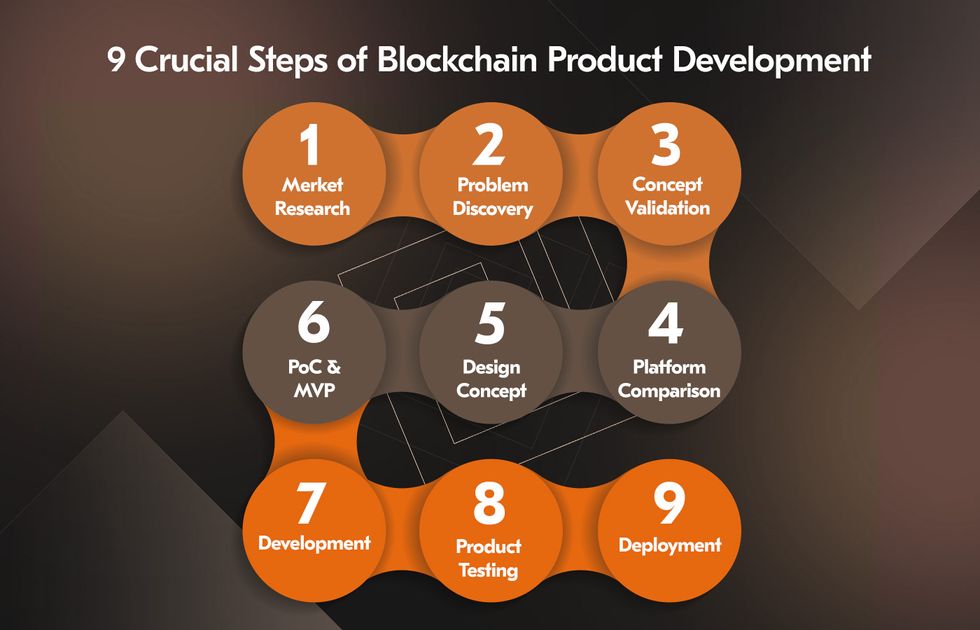
Successful blockchain app development lies in a structured strategy that blends technical planning, real-world validation, and thorough deployment. Below is a step-by-step breakdown of the typical development lifecycle that ensures your app is market-ready and sustainable.
Market Research. Start by analyzing the current market landscape. Explore how different industries use blockchain, identify trends, gaps, and potential demand for decentralized solutions.
Identify the Problem. Clearly define the problem your application aims to solve. Blockchain should enhance your solution by adding transparency, decentralization, or automation.
Develop and Refine Your Idea. Outline the core functionality and long-term vision. What value will your app offer users? How will decentralization improve it? Build user personas and use cases to validate your concept before investing in blockchain application development.
Compare Blockchain Platforms. Evaluate platforms like Ethereum, Polygon, Hyperledger, or Solana based on speed, cost, scalability, and consensus mechanisms. Your choice will directly impact performance and integration flexibility.
Design your Blockchain App. Focus on user experience, interface design, and smart contract architecture. A solid UX coupled with well-structured back-end logic ensures usability and trust.
Create a Proof of Concept. Develop a minimal version of your app to demonstrate feasibility. A PoC helps stakeholders test your approach before full-scale investment.
Development. Build smart contracts, configure the blockchain network, and integrate with front-end components. For enterprise use, low-code tools can speed up this phase significantly.
Test and Refine your Product. Run rigorous functional and security tests to catch vulnerabilities. Use both manual and automated testing to examine your app under real conditions.
Deployment. Once testing is complete, deploy the app on your chosen blockchain. Ensure monitoring tools are in place for ongoing performance and maintenance.
Challenges in Blockchain Development & How to Overcome Them
Although distributed ledgers offer massive potential across industries, developing blockchain applications comes with unique technical and strategic challenges. Addressing these early on is critical to building scalable, secure, and user-friendly solutions.
Regulatory Uncertainty
The legal status of blockchain apps varies widely across regions. From data privacy rules to cryptocurrency classifications, navigating this patchwork of laws can be complex.
Solution
Work closely with legal advisors and blockchain app developers who specialize in fintech and related regulations. Prioritize compliance by integrating flexible identity management and audit features from the outset. Staying up to date with international frameworks like MiCA in the EU or SEC guidance in the US will help minimize legal risks.
Scalability Issues
As user numbers grow, many blockchains suffer from slower transaction speeds and rising costs, especially on public chains like Ethereum.
Solution
Explore Layer 2 solutions (e.g., Optimism, Arbitrum), sidechains, or high-throughput platforms like Solana. Design your app to offload non-essential data off-chain. Architectural choices during development have long-term implications on scalability.
Skill Shortages
Blockchain apps require niche experience in cryptography, smart contract programming (e.g., Solidity), and decentralized architecture — talent that’s still in short supply.
Solution
Partner with an experienced blockchain app development company that can provide you with an expert, dedicated team of professionals whose expertise matches your ambitions and budget.
User Adoption Barriers
Despite growing popularity, dApps often suffer from poor UX, unfamiliar onboarding processes, and technical jargon.
Focus on intuitive design and seamless onboarding. If you decide to turn to blockchain application development services, make sure that the vendor offers in-app education, social logins, and fiat-to-crypto integrations to reduce friction.
Why Choose Acropolium?
With 20 years of experience in custom software development and 14 years dedicated to blockchain, Acropolium delivers trusted, future-proof solutions that power digital transformation across industries.
Recognized as capable blockchain app developers, our team has successfully built and deployed 87 blockchain-based systems, helping clients drive innovation, transparency, and operational efficiency.
As an ISO-certified company, we take a security and compliance-first approach to every project, ensuring all solutions are built on robust foundations of data integrity. And here’s one of the success stories to showcase it.
Case Study: Scalable Crypto Exchange Platform
A fast-growing crypto exchange turned to Acropolium’s blockchain app development services to build a platform that balanced usability, performance, and airtight security.
We developed a modular, scalable infrastructure with cloud-based load balancing and implemented cold wallet storage, multi-factor authentication, and advanced encryption protocols.
Results
- Gained 41,000+ new users in four months (43% in total user growth)
- Increased daily trading volume by 44%
- Lowered infrastructure costs by 30% via SaaS-based deployment
Final Thoughts
Blockchain has become foundational to secure, efficient, and transparent digital systems across industries. Yet, building scalable, high-performing blockchain apps in 2025 calls for a structured development process, regulatory awareness, and deep expertise in decentralized architecture.
That’s where a specialized development partner becomes critical, and Acropolium will be there for you. Through our subscription-based cooperation model, clients gain a flexible, long-term tech guide to support continuous improvement.
Contact us today to bring your future resilient blockchain product to market faster and with lower risk!









![Data Protection: [Best Practices for Secure Software Development]](/img/articles/secure-software-development-practices/img01.jpg)
![Renewable Energy Software Development in 2025 [Use Cases & Solutions]](/img/articles/software-for-renewable-energy-sector/img01.jpg)
![9 Big Data Use Cases Across Major Industries [2025 Guide]](/img/articles/big-data-use-cases-across-major-industries/img01.jpg)

![Retail Software Development Guide for 2025: [Features + Cost]](/img/articles/custom-retail-software-development/img01.jpg)
